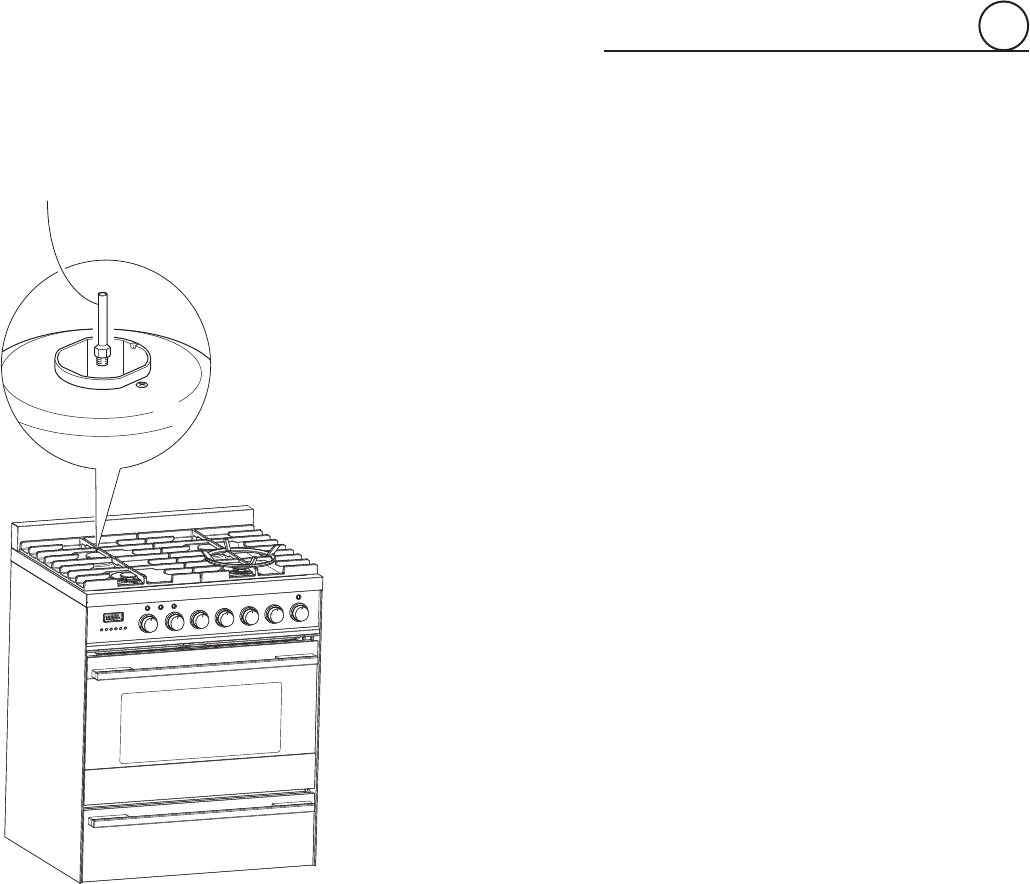
15
15
2
b. Any conversion required must be performed by your dealer or a qualifi ed licen-
sed technician or gas service company. Please provide the service person with
this manual before work is started on the range. (Gas conversions are the re-
sponsibility of the dealer or end user.)
c. This range can be used with NATURAL or LP/PROPANE gas. It is shipped from
the factory adjusted for use with NATURAL gas.
d. Manifold pressure should be checked with a manometer and by operating as
below detailed:
• Remove the orifi ce from the rear left (or rear right) burner and mount the
proper test point adapter which is available from the After-Sales Service
(see side fi gure and the “OPERATIONS TO BE PERFORMED WHEN SUB-
STITUTING THE ORIFICES” chapter).
• Turn the rear left (or rear right) burner control knob to the maximum position.
• Press the knob and keeping it pressed check the manifold pressure with a
manometer; NATURAL gas requires 4.0” W.C.P. and LP/PROPANE requires
11.0” W.C.P.
• Incoming line pressure upstream from the regulator must be 1” W.C.P. hi-
gher than the manifold pressure in order to check the regulator.
• The regulator used on this range can withstand a maximum input pressure
of 1/2 PSI (14.0” W.C.P). If the line pressure is in excess of that amount, a
stepdown regulator will be required.
e. The appliance, its individual shut-off valve, and pressure regulator must be di-
sconnected from the gas supply piping system during any pressure testing of
that system at pressures in excess of 1/2 PSI (3.5 kPa).
f. The appliance must be isolated from the gas supply piping system by closing its
individual manual shut-off valve during any pressure testing of the gas supply
piping system at test pressure equal to or less than 1/2 PSI (3.5 kPa).
3. Flexible Connections:
If local codes permit, CSA or UL design-certifi ed, fl exible metal appliance connector
is recommended for connecting this range to the gas supply line. Do Not kink or da-
mage the fl exible connector when moving the range. The pressure regulator has 1/2”
NPT female pipe threads.You will need to determine the fi ttings required, depending
on the size of your gas supply line, fl exible metal connector and shutoff valve.
4. Rigid Pipe Connections:
If rigid pipe is used as a gas supply line, a combination of pipe fi ttings must be used to
obtain an in-line connection to the range. All strains must be removed from the supply
and fuel lines so the range will be level and in line.
• Use joint compounds and gaskets that are resistant to action of natural or propa-
ne gas on all male pipe threads.
• Do not over tighten gas fi tting when attaching to the pressure regulator. Over
tightening may crack the regulator.
5. Leak Testing:
IMPORTANT: Leak testing of the appliance shall be conducted as follows:
• After fi nal gas connection is made, turn on manual gas valve and test all con-
nections in gas supply piping and appliance for gas leaks with a soapy water
solution. During this test all appliance gas valves have to be closed.
• In order to avoid property damage or serious personal injury, never use a Iighted
match. If a leak is present, tighten joint or unscrew, apply more joint compound,
tighten again and retest connection for leak.
Fig. 2.5
TEST POINT ADAPTER
The Test Point adapter is available from the
After-Sales Service.


















